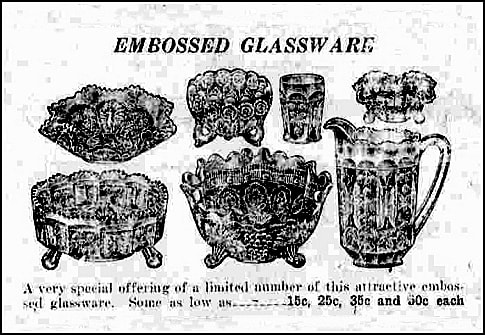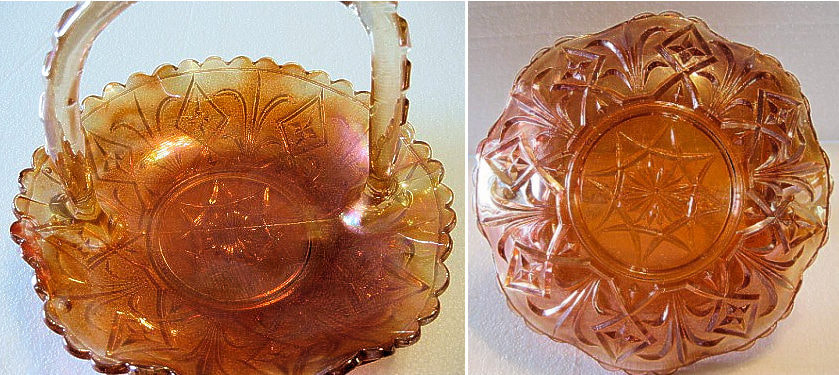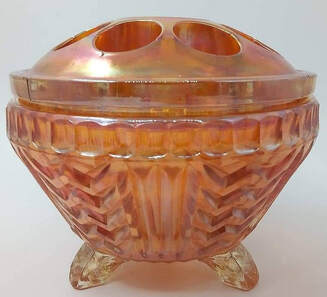NetworK ezine Issue 90. November 2022
Totally Devoted to Carnival Glass
Welcome to our November issue of NetworK. Included in this issue are several special items. We have an astonishing discovery from the Zabkowice glassworks in Poland: an exquisite and rare Boar novelty paperweight. There is also a NetworK "exclusive reveal" of several more Carnival patterns that we have positively identified as products from the English glassmaker, Matthew Turnbull. Turnbull’s Carnival deserves to be fully recognised; indeed, they made some distinctive and unusual items that have been found in many countries around the world. We also have other "reveals" which might just save you money, or help you avoid buying something that turns out to be a reproduction.
The ad, above left, was featured in a November, 1920 edition of the “Chickasha Daily Express” (Chickasha is a town in central Oklahoma). A full page of the newspaper featured a large ad for the opening of the Buie & Wallace Gift Store – and there among the “Boys’ Velocipedes”, “Next-to-Nature Baby Dolls” and “Cute Cinnamon Teddy Bears” was this ad showing a fine range of Fenton’s glassware.
On its right is the identical ad in March 1921 Butler Brothers catalogue – as you can see, the presentation is much better and clearer.
The items are recognisable as Fenton’s Butterfly and Berry, as well as the Peacock and Grape bowl, Orange Tree (aka Fenton Flowers rose bowl), a large Grape and Cable footed bowl with a Persian Medallion interior and what appears to be a Panther footed berry (top right).
Two things caught our attention. Firstly, the difference between the wholesale price in Butler Brothers (where the cost of the assortment was averaged out at 16½ cents for each item), and the retail store prices of between 15 cents and 50 cents (presumably they were priced according to size).
Secondly, was how the “Chickasha Daily Express” ad headed up and described the items as “Embossed Glassware”. Usually, Butler Brothers and other catalogues of the era titled the Fenton and other assortments as “Iridescent Glassware” – also offering attractive titles like “New Aurora Glassware” (as in the one here). The terms used to describe and attract the buyers were generally based around the iridescent effect. The use of “Embossed Glassware” as the main heading appears to have been intended to draw attention to the (“embossed”) patterns, rather than the shimmering colours. In fact, iridescence wasn’t even mentioned in the “Chickasha Daily Express” ad. They surely missed a selling point there!
Why Embossed?
“Embossed” in the ad is referring to the raised-up nature of the pattern – it’s also called cameo, meaning that the design stands up off the surface of the glass. The opposite is intaglio, where the pattern appears to be cut in or incised into the surface of the glass. Both cameo and intaglio designs are found on Carnival and other press-moulded glass.
How is it achieved? For an embossed, cameo result, the design is cut into the surface of the mould (or the plunger) and so the pattern appears in relief (raised up, embossed) on the surface of the glass item. Conversely, where a design is created by cutting away unwanted areas of the mould and thus leaving the desired design raised up from its surface, the resulting pattern will be incised, or cut into the surface of the glass (as in many geometric designs). This is known as intaglio.
Roses in Cameo and Intaglio
A great example of a cameo pattern is Northwood’s amazing Rose Show, where the roses are raised up off the surface, almost as if they have been modelled in icing sugar and placed on top.
A great example of a cameo pattern is Northwood’s amazing Rose Show, where the roses are raised up off the surface, almost as if they have been modelled in icing sugar and placed on top.
A Zabkowice Discovery
An astonishing discovery was featured in our Network Facebook group in late October.
Kamil Świerczyna from Poland showed us a magnificent example of Carnival Glass from Zabkowice. It is an exquisite Boar novelty (a paperweight).
An astonishing discovery was featured in our Network Facebook group in late October.
Kamil Świerczyna from Poland showed us a magnificent example of Carnival Glass from Zabkowice. It is an exquisite Boar novelty (a paperweight).
|
Kamil writes: “My boar was created between 1920 and 1936 and was product for export to the USA.” To add to the surprise, it is blue base glass, which is exceptionally rare. On the left is an extract from the 1912 Zabkowice catalogue, courtesy Siegmar Geiselberger, and to its right is the base of the Boar novelty - there is no mistaking the rich, cobalt blue base glass! Grateful thanks to Kamil Świerczyna for his research and for allowing us to show you his wonderful photos of his splendid item. All photos are Copyright and courtesy of Kamil Świerczyna. |
Turnbull Revelations
Back in 2009 we discovered a couple of pages from a Matthew Turnbull catalogue, which enabled us to solve some long-standing mysteries as well as uncovering some fascinating fresh discoveries.
Back in 2009 we discovered a couple of pages from a Matthew Turnbull catalogue, which enabled us to solve some long-standing mysteries as well as uncovering some fascinating fresh discoveries.
|
And now we can add more! Before we go any further, for those who are not familiar with Matthew Turnbull, here is a little background information. The factory – known as the Cornhill Glass Works and located in Southwick, Sunderland, in the north-east of England – was established in the 1860s. Thomas Joyce, who researched the company, reported that Turnbull were very dependent on Woolworths (a popular department store) for their sales outlet, and when they lost that contract in 1953, Turnbull’s Cornhill Glass Works closed. |
1892 Pottery Gazette ad
|
The original few pages that we found dated from c. 1930s (we believe). In 2010, a Turnbull ad from the 1951 British Pottery Gazette came to light (thanks to Thomas Joyce) and we were able to solve more Carnival puzzles through it. All the information about this is already on our website (links at the foot of this section). And now, more revelations (courtesy Tyne & Wear Museum archive) from a 1951 catalogue, published just two years before the factory closed. We will soon be updating our website to include all the new information, but for now, let’s feature the new discoveries and get them on the NetworK record.
Lyre, Original Maker’s Name SATURN (543 Range). Matthew Turnbull, England.
We are delighted that not only do we have a maker for this seldom-seen item, but we also have the original name given to the pattern line by Turnbull. It was called Saturn. A full seven-piece fruit set was made, as well as a sugar and creamer.
Frills and Diamonds (aka Diamonds and Frills), Original Maker’s Name STANDARD (476 Range). Matthew Turnbull, England.
In our website feature on Turnbull (based on our earlier research and discoveries) the Frills and Diamonds pattern is one that we felt could be a Turnbull piece, based on various characteristics and similarities of style. Now we have the catalogue proof to confirm our belief! Here it is in the 1951 Turnbull catalogue – pattern 476 called Standard. You can see the unusual and distinctive base of these items in the images below.
In our website feature on Turnbull (based on our earlier research and discoveries) the Frills and Diamonds pattern is one that we felt could be a Turnbull piece, based on various characteristics and similarities of style. Now we have the catalogue proof to confirm our belief! Here it is in the 1951 Turnbull catalogue – pattern 476 called Standard. You can see the unusual and distinctive base of these items in the images below.
Towers vase, Original Maker’s Name WINDSOR (504/T Range). Matthew Turnbull, England.
|
In our book “Carnival Glass The Magic & Mystery 2” (2008) we attributed the Carnival Glass examples of the Towers vase to Matthew Turnbull, following our discussions with Davidson Glass experts, Chris and Val Stewart. The Stewarts had explained to us that the mould for this vase was named "M.T.1" and was purchased by Davidson in the mid-late 1950s after Turnbull’s glass works closed down. They confirmed that Davidson did not make any Carnival and that all iridescent versions of this item would be Turnbull’s. |
|
We repeated the Turnbull attribution in our 2019 “Carnival Glass from Europe” encyclopedia eBook. And now we have catalogue proof as well as the original maker’s name! This pattern was part of a full range of shapes named Windsor, and we were amused to see that the vase was marketed both as a sugar and a posy vase (with a flower block/frog). Just remember to wash between uses!
It's interesting to note that the Windsor Range also had a variation in which a series of circles appear between the peaks. We are not currently aware of this in Carnival, but it is possible. The version with the circles was number 504 (shown right), and the Towers vase version without the circles was 504/T. |
Hobstar Reversed, Original Maker’s Name GRANVILLE (495 Range). Matthew Turnbull, England.
This is the one item that really shook us in 2009, when we first came across the Matthew Turnbull catalogue extract pages dating from the 1930s. Although we have known since 2009 that this was a Turnbull item, it was a pleasure to see the illustration (complete with floral bouquet) in the 1951 catalogue as well.
Diamond Point basket, Original Maker’s Name HANNOVER (480 Range). Matthew Turnbull, England.
This distinctive basket, on which several different patterns can be found (Diamond Point, May Basket, Maple Leaf, Duchesse, and King George) was attributed by us back in 2009, to Matthew Turnbull’s glass works. But now we also have an illustration of it in the 1951 catalogue, and the pattern name – Hannover.
This distinctive basket, on which several different patterns can be found (Diamond Point, May Basket, Maple Leaf, Duchesse, and King George) was attributed by us back in 2009, to Matthew Turnbull’s glass works. But now we also have an illustration of it in the 1951 catalogue, and the pattern name – Hannover.
|
Diamond Point May Basket, aka Fleur de Lys basket. Matthew Turnbull's Basket No. 480. OMN Hannover.
Photos courtesy Lesley Smith.
You can read much more about these May Baskets on our website (links at the foot of this section). |
And here is a puzzle – Spears and Chevrons
Whilst all the previous patterns shown in this special research feature are confirmed attributions to Matthew Turnbull, we’ll close this with a puzzle.
This piece was featured in our NetworK Facebook group recently by Ann Sarah Mulford. Although we feel that it is possibly a Turnbull item, as yet we do not have the catalogue proof. The photos are all Copyright and courtesy of Sarah Ann Mulford.
Whilst all the previous patterns shown in this special research feature are confirmed attributions to Matthew Turnbull, we’ll close this with a puzzle.
This piece was featured in our NetworK Facebook group recently by Ann Sarah Mulford. Although we feel that it is possibly a Turnbull item, as yet we do not have the catalogue proof. The photos are all Copyright and courtesy of Sarah Ann Mulford.
We have only ever seen one other example of this rose bowl so clearly it is a scarce item. The pattern style, the shape, the feet and the flower block are all suggestive of Matthew Turnbull’s work – but for now, without catalogue proof, we will simply say maker not yet known. Our thanks to Sarah for enabling us to show you this intriguing item.
Further Reading
Our research in the early 2000s identified that Matthew Turnbull made Carnival Glass. Here are two links to our work on Turnbull:
Further Reading
Our research in the early 2000s identified that Matthew Turnbull made Carnival Glass. Here are two links to our work on Turnbull:
Grapevine Lattice
Shown below, left is a Classic old Grapevine Lattice tumbler in purple, by Dugan-Diamond. It's a delightful design that sits half-way between stylised and realistic, and looks at its most magnificent on their purple base glass with an electric blue iridescence. The pitcher, also in purple, is shown on the right (courtesy of Seeck Auctions); it was mould-blown with a (non-iridised) applied handle.
Shown below, left is a Classic old Grapevine Lattice tumbler in purple, by Dugan-Diamond. It's a delightful design that sits half-way between stylised and realistic, and looks at its most magnificent on their purple base glass with an electric blue iridescence. The pitcher, also in purple, is shown on the right (courtesy of Seeck Auctions); it was mould-blown with a (non-iridised) applied handle.
|
The Classic design appears to have been introduced in c. 1912, a year before Tom Dugan left the firm and the factory subsequently became Diamond Glass, as it appears in Butler Brothers catalogues in 1912 (above, centre), However, we cannot find it at all in any later catalogues.
In this 1912 Butler Bros ad, the Grapevine Lattice pitcher and tumbler are part of a “Vineyard” duo, accompanying Dugan’s Floral and Grape pitcher and tumbler. Although the Floral and Grape pitcher continued to be offered in 1915, through to 1919, it was paired with the Daisy and Lattice pitcher and tumbler, not Grapevine Lattice. As the Grapevine Lattice water set is not seen too often (and was not in Butler Brothers after 1912), we feel that it was not actually produced during the Diamond years, that is 1913 to 1931, although the similarly patterned bowl was certainly made during those later years. Interestingly, both these ads make use of the "embossed" description. Reproductions The moulds for the Grapevine Lattice tumbler and pitcher were undoubtedly retained during the Diamond years, as we know that they (and other Dugan-Diamond moulds) were later acquired by Si Wright. In 1978, a purple water set called "Grape Vine Lattice" was made in Revival era Carnival Glass, by Westmoreland Glass for L.G. Wright - as shown below. Left: an extract from L. G. Wright’s 1978 catalogue, courtesy Glass Paper Fanatics.
Right: the L. G. Wright so-called "wonky N" mark. |
Butler Brothers extract from 1918, showing Dugan’s Floral and Grape pitcher alongside Daisy and Lattice pitcher.
These Westmoreland/L G Wright reproductions both delighted and alarmed the collecting public, according to contemporary 1978 accounts in Dorothy Taylor’s “Encore” journal. People felt that they looked beautiful, but there was a general warning that many of the Wright reproductions were not signed, and those that were had a W with a line under it enclosed in a circle, which has become known as the "wonky N" mark.
There’s no doubt that it could be seen as Northwood's signature N mark - which might seem a bit crazy to today’s knowledgeable collectors! However, back in 1978 it was believed that Northwood had originally made these items (as they didn’t know about Dugan-Diamond). There are also some custard glass reproductions of the Grapevine Lattice bowl that have a very convincing N in a circle underlined trademark. So, is there a fool-proof way of spotting the Wright reproductions? Look for the W/N mark of course, and check the handle on the pitcher. We haven’t examined any closely, but we feel it’s probable that the handles on the reproductions were iridised (the Classic old examples were not iridised). |
We will be creating a L. G. Wright feature on our website in the future, that will show many of the Carnival patterns reproduced for Wright. Meanwhile, here are three links to read more about L. G. Wright reproductions in Carnival.
STOP PRESS: A.A. Importing catalogue
We felt that readers would like to see this 1986 extract from the A.A. Importing catalogue (courtesy of Glass Paper Fanatics). There are a number of instantly recognisable items here and we hope this will help collectors. More details and illustration to follow in the next issue of NetworK.
We felt that readers would like to see this 1986 extract from the A.A. Importing catalogue (courtesy of Glass Paper Fanatics). There are a number of instantly recognisable items here and we hope this will help collectors. More details and illustration to follow in the next issue of NetworK.
Extract from the 1986 A. A. Importing catalogue, courtesy Glass Paper Fanatics.
To see this catalogue page full sized, including several non-Carnival "Art Glass Containers", click on the image above, or go here: A.A. Importing 1986
To see this catalogue page full sized, including several non-Carnival "Art Glass Containers", click on the image above, or go here: A.A. Importing 1986
Privacy and the use of your information: we only use your name and email address to send you your Carnival Glass NetworK ezine. We will not share your name or email address with anyone else, or use it for any other purpose. You can change your mind about receiving your NetworK ezine at any time by clicking the unsubscribe link at the foot of every issue, or by emailing us at [email protected]
Join us on Facebook
We invite you and your friends to join us all on NetworK's fast growing and very active Facebook Group (link is below), and if you have missed any of the previous issues of NetworK and NetworK Specials, they are all here: Back Issues.
We invite you and your friends to join us all on NetworK's fast growing and very active Facebook Group (link is below), and if you have missed any of the previous issues of NetworK and NetworK Specials, they are all here: Back Issues.





























